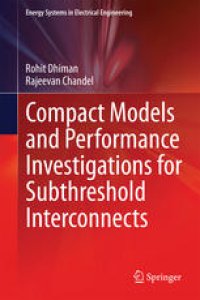
Ebook: Compact Models and Performance Investigations for Subthreshold Interconnects
- Tags: Circuits and Systems, Electronics and Microelectronics Instrumentation, Power Electronics Electrical Machines and Networks, Signal Image and Speech Processing
- Series: Energy Systems in Electrical Engineering
- Year: 2015
- Publisher: Springer India
- Edition: 1
- Language: English
- pdf
The book provides a detailed analysis of issues related to sub-threshold interconnect performance from the perspective of analytical approach and design techniques. Particular emphasis is laid on the performance analysis of coupling noise and variability issues in sub-threshold domain to develop efficient compact models. The proposed analytical approach gives physical insight of the parameters affecting the transient behavior of coupled interconnects. Remedial design techniques are also suggested to mitigate the effect of coupling noise. The effects of wire width, spacing between the wires, wire length are thoroughly investigated. In addition, the effect of parameters like driver strength on peak coupling noise has also been analyzed. Process, voltage and temperature variations are prominent factors affecting sub-threshold design and have also been investigated. The process variability analysis has been carried out using parametric analysis, process corner analysis and Monte Carlo technique. The book also provides a qualitative summary of the work reported in the literature by various researchers in the design of digital sub-threshold circuits. This book should be of interest for researchers and graduate students with deeper insights into sub-threshold interconnect models in particular. In this sense, this book will best fit as a text book and/or a reference book for students who are initiated in the area of research and advanced courses in nanotechnology, interconnect design and modeling.
Compact Models and Performance Investigations for Sub-threshold Interconnects provides a detailed analysis of issues related to sub-threshold interconnect performance from the perspective of analytical approach and design techniques. Particular emphasis is laid on the performance analysis of coupling noise and variability issues in sub-threshold domain to develop efficient compact models. The proposed analytical approach gives physical insight of the parameters affecting the transient behavior of coupled interconnects. Remedial design techniques are also suggested to mitigate the effect of coupling noise. The effects of wire width, spacing between the wires, wire length are thoroughly investigated. In addition, the effect of parameters like driver strength on peak coupling noise has also been analyzed. Process, voltage and temperature variations are prominent factors affecting sub-threshold design and have also been investigated. The process variability analysis has been carried out using parametric analysis, process corner analysis and Monte Carlo technique. The book also provides a qualitative summary of the work reported in the literature by various researchers in the design of digital sub-threshold circuits. This book should be of interest for researchers and graduate students with deeper insights into sub-threshold interconnect models in particular. In this sense, this book will best fit as a text book and/or a reference book for students who are initiated in the area of research and advanced courses in nanotechnology, interconnect design and modeling.